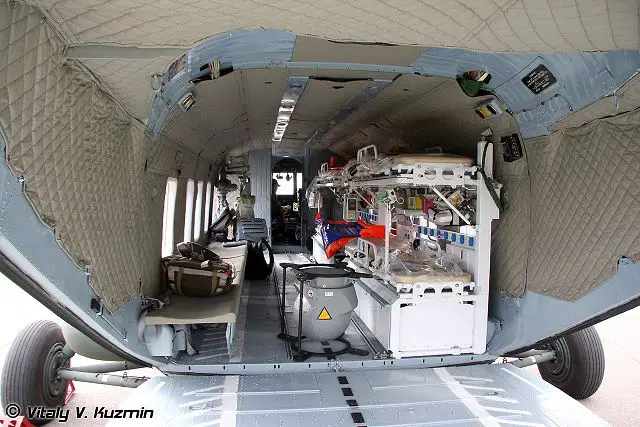In the future Russian Armed Forces will have 23 airmobile medical brigades TASS 12709164
|
|
|||
|
Armies in the world - Russian army
|
|||
|
|
|||
| In the future Russian Armed Forces will have 23 airmobile medical brigades. | |||
|
In several years, the Russian Armed Forces will activate 23 airmobile medical brigades capable of rendering medical aid to heavily wounded personnel and evacuate them from the battlefield, according to the Izvestia daily.
|
|||
|
|
|||
 Inside view of Mi-17 Medevac helicopter at MAKS 2009 (Photo copyright Vitaly Kuzmin) Inside view of Mi-17 Medevac helicopter at MAKS 2009 (Photo copyright Vitaly Kuzmin) |
|||
|
|
|||
|
According to Defense Ministry Main Medical Directorate Chief Alexander Fisun, the brigades will be equipped with versatile medical evacuation modules outfitted with cutting-edge diagnostic equipment and resuscitation and volume ventilator systems. The modules are commonized with all military transport planes and helicopters in terms of dimensions and attachments while their equipment is integrated with the same equipment used in military hospitals. According Gen. Fisun, the introduction of this hardware will boost the chances for survivability for military and civilian casualties of terrorist attacks and natural disasters.
The primary mission of the military medics is to preserve the life of every service member and civilian in natural or man-made disaster-stricken areas, Fisun stressed. The first medical aid administered too late is the main cause of the losses suffered in armed conflicts and man-made and natural disasters. The medevac modules, which are being introduced, allow both the correct diagnosis of a wounded or injured person and his/her prompt delivery to hospital. According to Fisun, the Defense Ministry has saved more than 100 lives over the first two years of the trial operation of the advanced medevac modules, including a girl from Aleppo, who was gravely wounded by the blast of an artillery round fired by the militants. It is the advanced modules that the Russian military medics used for rendering her first aid and transporting her to Moscow for treatment. A feature of the module is that it allows medevac right form the battlefield, according to Georgy Mushtakov, director general of the Kazan Aggregate Plant, the manufacturer of helicopter components and equipment and medevac modules as well. The module has high cross-country ability and a self-contained operating capability of 6 h, which is enough for both removing a casualty from the battlefield and bringing him or her to the nearest stationary hospital. Mushtakov emphasized that the module could be attached to the body of any wheeled vehicle irrespective of its being wooden or metal. |
|||
|
|
|||
 Russian armt BTR-MD ambulance version Russian armt BTR-MD ambulance version |
|||
|
|
|||
|
The company was tasked with developing medevac equipment with the commonality from the medical battalion, i.e. the combat medic level, to the top-notch stationary hospital, with casualties to be evacuated to the hospital without the medical equipment and medical probes attached to them having to be removed, Mushtakov stressed.
Fisun added that the medevac module is integrated with the personal electronic cards being introduced by the Russian military - electronic dog tags designed to oust all hardcopy paperwork ranging from a service member’s ID, hardware access certificate and security clearance to his/her medical record. After connecting a casualty to the module, combat medics will have access to the soldier’s previous medicals, diagnoses and contraindications and save the information on the newly administered medical aid for doctors at the hospital. This will heavily reduce the probability of medical errors when a wounded soldier is brought from the battlefield to a hospital. The Defense Ministry has been using 25 versatile medevac modules, the general said, with 15 tailored to fixed-wing aircraft and 10 to rotary-wing ones. Plans provide for buying 15 modules more to field them with all of the military districts. The plane-tailored and helicopter-adapted modules differ only in appearance, the former designed for four casualties and the latter for two. The Ilyushin Il-76 (NATO reporting name: Candid) military transport aircraft accommodates five four-bed modules, i.e. 20 casualties. The Mil Mi-8 (Hip) helicopter carries four wounded troops. The development of similar evacuation systems for the advanced Ansat helicopter, BMP-3 infantry fighting vehicle’s medevac derivative and Antonov An-148 and Sukhoi Superjet passenger planes has been ordered, according to the Izvestia daily. |
|||


























